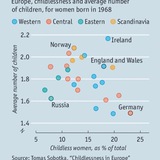The fall in births in Taiwan last month was so extreme that births for the January-May 2025 period are now down more than 13% below the level for the same period last year. Taiwan on a trajectory to hit South Korean (sub 0.80) fertility levels.
Almost twice as many South Korean men as women want a large family of 3 kids or more. 22% of men want 3 or more children while only 12% of women do. & far less than 12% actually end up having 3 kids.
Italy is basically the opposite of South Korea with far more women expressing 3+ children as the ideal (22%) than men (13%). Hungary is interesting in that both a relatively high number of men & women (28% & 23% respectively)have a 3+ child ideal yet Hungarian TFR is sub 1.4.
Italy is basically the opposite of South Korea with far more women expressing 3+ children as the ideal (22%) than men (13%). Hungary is interesting in that both a relatively high number of men & women (28% & 23% respectively)have a 3+ child ideal yet Hungarian TFR is sub 1.4.
Estonian births down 10% year on year, Lithuanian down 14%+, Latvian down 12% plus. All the Baltic states are on track to have a TFR of 1.10 or below this year.
The Millennial generation (1981-1996) of the EU was comprised of 80,872,905 births while the US saw 61,973,042 births during that period. A difference of 18,899,863. For Gen Z (1997-2012) EU saw 71,657,145 births against 65,094,653 for the US. A difference of just 6,562,492.
The furthest Southern Region of Chile and the furthest Southern Province of Argentina both have sub 1.0 fertility rates. They are 0.93 for Chile’s Magallanes Region (population 165,593) & 0.98 for Argentina’s Tierra del Fuego Province (population 190,641).
The UN estimates Somalia’s population will triple over the next 75 years. This is based solely on the assumption that their fertility rate stays around the high level it is now. It will not. Also Somalia is currently on the brink of famine. 35M much more likely than 60M.
The pronatalist measures being proposed by Vice President JD Vance (such as a $5,000 handout/credit for new parents) seemed destined to barely move the needle. Hungary spends 5.5% of GDP annually on pro-natal benefits & they have a TFR of 1.38 as of 2024.
South Korea, Poland, Japan, & a host of other countries have already tried tax breaks, subsidized childcare, cash handouts, generous maternity & paternity leave, & more to little avail. Doing the same thing over & over & expecting different results is well…
Used to think such pro-natalist measures (particularly tax incentives) could work. But the “results” in most countries seem to be parents having the same number of children but sooner (resulting in a brief upward blip in births followed by a crash). The answer? Cultural change that puts the family at the center of society, not cash.
https://t.co/o2Zs35un6Z
South Korea, Poland, Japan, & a host of other countries have already tried tax breaks, subsidized childcare, cash handouts, generous maternity & paternity leave, & more to little avail. Doing the same thing over & over & expecting different results is well…
Used to think such pro-natalist measures (particularly tax incentives) could work. But the “results” in most countries seem to be parents having the same number of children but sooner (resulting in a brief upward blip in births followed by a crash). The answer? Cultural change that puts the family at the center of society, not cash.
https://t.co/o2Zs35un6Z
The Economist
Why MAGA’s pro-natalist plans are ill-conceived
Efforts to deliver a baby boom either fail or cost a fortune
This is a topic this account has longed harped on. By the time Germany’s largest age cohorts have retired in 2030 there will not be huge waves of semi skilled Eastern European immigrants as there were from 1990-2015. At the same time German’s economy is decelerating.
There is a significant crisis ahead for Germany that is basically unavoidable. Having a sub replacement fertility rate since 1972 has consequences.
There is a significant crisis ahead for Germany that is basically unavoidable. Having a sub replacement fertility rate since 1972 has consequences.
Russia seeing inevitable collapse in births due to small cohort born from 1994-2003 now being in prime child bearing years. Very likely 2025 births will fall below 1.2 million for the 1st time. Birth dearth to last until at least 2030 regardless of economic or social conditions.
In fact, if Russia was seeing Belarusian or Polish level TFR births would already be below 1 million annually.
In fact, if Russia was seeing Belarusian or Polish level TFR births would already be below 1 million annually.
Demographics Now and Then
Russia seeing inevitable collapse in births due to small cohort born from 1994-2003 now being in prime child bearing years. Very likely 2025 births will fall below 1.2 million for the 1st time. Birth dearth to last until at least 2030 regardless of economic…
The Ukrainian cohort born since 2017 smallest by a lot, with every year since beating the previous record low of 376,478 births set in 2001 & being lower than the year before. Seems unlikely that births will ever go back above 375,000 (they were 176,679 last year).
A very specific area of Eastern Europe (the Baltic States, Poland, & Belarus) are all seeing TFR head to the 1.0-1.1 level of late. Belarus likely to be the worst impacted moving forward as they have the double whammy of catastrophically low TFR & high emigration.
Chart from @birthgauge
Chart from @birthgauge
